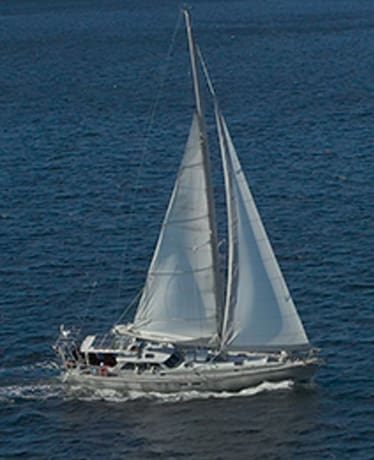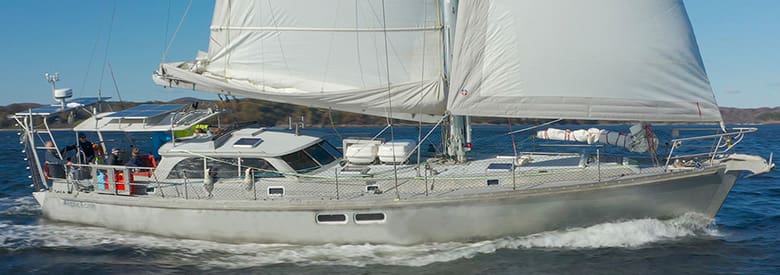
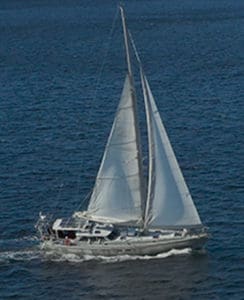
Some vessels just look the part and that’s certainly the case for the 56-foot aluminum expedition sloop Arctic Earth. Based in Camden, Maine, Arctic Earth is a vessel designed and outfitted to sail to high latitudes. The boat is operated by David Conover and Compass Light Productions, a documentary film company focused on science and environmental content and specially tuned to Arctic issues. Compass Light has produced more than 600 films for outlets like Discovery Channel, Science Channel, PBS Nova and more.
A few years ago Conover decided to look for a boat that would augment Compass Light’s work in the Arctic. “I was interested in a platform that would support that work going forward,” Conover said. “A way to focus the stories we’re producing.” He looked at an older steel vessel but it didn’t quite fit. Then he heard about the Good Hope 56 design drawn by naval architect Ed Joy also based in Camden. Four boats of the Good Hope design had been built by Jacobs Brothers in Cape Town, South Africa. Conover found the boat that would become Arctic Earth on the hard in Grenada. The boat had been built in 2016, sailed for two years, hauled in 2018 while its owners, a French couple who are both medical doctors, took a break from cruising. Then the COVID 19 pandemic hit and the boat was put up for sale. Conover made the purchase and had the boat refitted for arctic work.
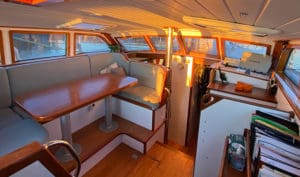
An intriguing feature of this pilothouse sloop is its swing-up rudder and lifting keel. Arctic Earth captain Magnus Day explains in an interview from the Arctic Earth site: “A 56-foot aluminum monohull sailboat with a swing keel design. She’s a little bit unusual, with this swing rudder and keel, which retracts right into a well. With our keel and rudder up, we have a draft of about one meter. We can sit on the beach or navigate very shallow waters. Sitting on the beach is handy to effect repairs…. We can go into shallow anchorages that only have four to five feet of water, an advantage in the higher latitudes and being able to escape the icebergs.”
Arctic Earth has a draft of three feet two inches with the keel raised and eight feet nine inches with the keel down. Stability is provided by 21,460 pounds of ballast.
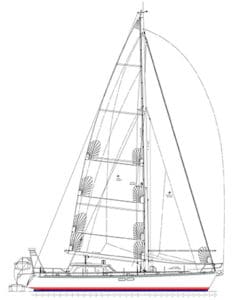
The sails are by Ullman Sails. The main has three slab reefing points and is reefable from the cockpit. There’s a trysail with a separate track, a hank-on staysail and a roller-furling 110 percent headsail. Water tankage is 264 gallons, plus a Spectra Cape Horn watermaker. Fuel supply is 573 gallons of diesel (plus day tank), providing its John Deere 4045TFM engine with a range of 2,000 nautical miles at seven knots. On the electrical systems side, Arctic Earth has 400 watts solar power, 24/240 volt engine battery bank charged by engine alternator, Sonnenshein house battery bank charged by Yanmar 2GM20 18 horsepower generator with a140 amp 24 volt Balmar alternator and a Honda 2000e spare generator.
Arctic Earth has a full suite of dive gear including an air compressor, and to advance its documentary and research roles, it has drones, an underwater ROV, various cameras, a Dolphin Hydrophone with 30 feet of cable and rock climbing and mountaineering gear. The vessel accommodates as many as six: four expeditioners plus a captain and mate. Accommodations are scheduled to be expanded this year with two additional berths.
Arctic Earth is available for full vessel charter by other media-makers, field researchers, and small private groups. Conover sees what he calls “three buckets” of possible charterers of the boat: 1) Compass Light for its own productions; 2) scientific researchers engaged in multi-year projects in the Arctic; and 3) private groups intrigued by the issues of the far north, having a love of sailing and wanting to go on family trips, ski trips or climbing expeditions in the region. See the Arctic Earth website (arcticearth-charter.com) for more details.

